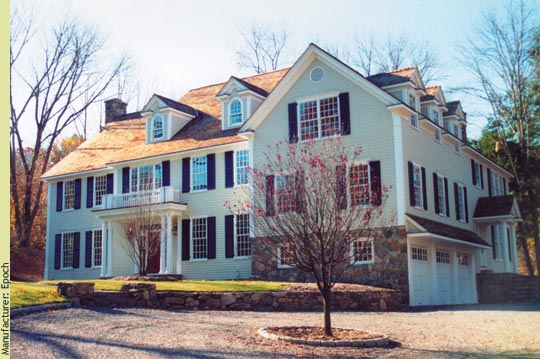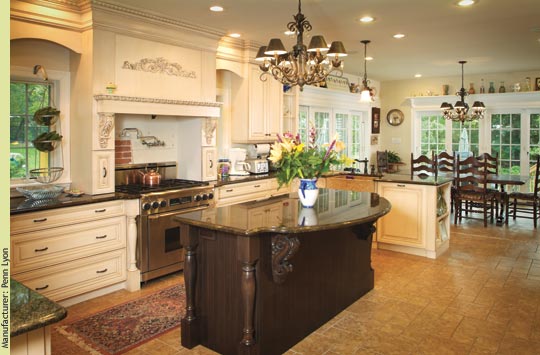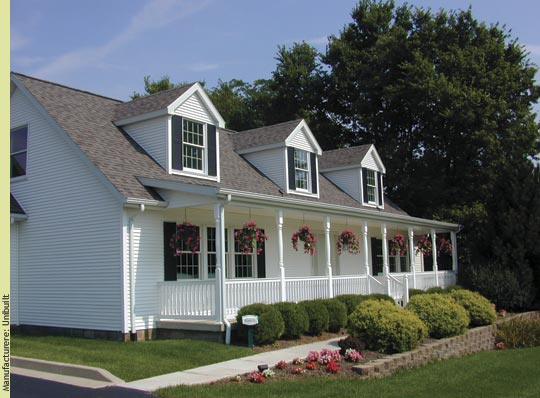|
A brief summary of Chapter 9 "Financing a Modular Home" (16 pages) in
The Modular Home, by Andrew Gianino, President of The Home Store To build a modular home you need to pay the dealer for the modules and the general contractor for his services. If you do not own a building lot, you need to purchase it as well. There are three typical sources of these funds. The first is private funds, such as personal savings, an equity loan on another property, the sale of personal assets, or a family loan. The second is a lending institution, usually a bank, credit union, or mortgage company. The third source is the modular dealer or GC. There is one very significant difference between paying for an existing home and paying for a new home. When you buy an existing home you pay the seller in full before you take possession of the home. If you use a loan to pay for the home, you secure the funds with a mortgage. When you build a home, you make periodic payments as work is completed. This process protects you and your lender should something prevent the builder, in this case the dealer and the GC, from completing the home. You cannot wait until the home is completely finished to pay the dealer and GC in full because they need funds to pay for materials and labor as the project progresses. Receiving compensation as the job progresses also protects the dealer and GC should something prevent you from paying for the finished home. When you use a lender to build a home, you obtain a "construction loan," which is a short-term loan usually of four- to twelve-months' duration. The loan provides for a series of payments as work is completed. Once the local building inspector issues a certificate of occupancy and the lender agrees that the home is essentially complete, the lender pays off the construction loan and issues you a mortgage. Although you will still need to obtain a mortgage, you will not need to secure a construction loan if the dealer or GC finances the construction. They are more likely to do this if the dealer is completing the GC work, but especially if the dealer or GC own the land. Ownership of the land and responsibility for the construction tasks gives them greater control of the project and reduces their risk should you decide not to purchase the finished home. When you purchase a modular home that is funded in full by the dealer or GC, you are in a sense purchasing an already existing home. In fact, you will not take ownership of it until you pay them when they are done. That is why they are likely to require you to provide evidence that you have secured a mortgage or have the personal funds to pay for the finished home. Since paying for the home after it is completed does not require you to make a series of payments, it eliminates the steps discussed below. 
The stately elegance of old New England
With the advent of the Internet, you have many potential lenders to choose from. You also have more financing products to consider. Ask the lenders you are considering whether your income, assets, liabilities, and credit history qualify you for a loan. Seek their opinion and perhaps the advice of a financial adviser before deciding whether to select a fixed or variable rate, a term of 30 or 15 years, or a down payment of 20, 10, or 5 percent. Many lenders have a wealth of helpful information available on their Web sites, but it is unlikely that any lender will teach you about financing the construction of a modular home in much depth. This chapter will fill that void. Not all lenders offer construction loans in addition to mortgages, and you will need one that does. Customers sometimes run into delays and misunderstandings when they begin looking for existing homes and then decide to build a new home. They assume that the lender who preapproved a loan on an existing home will automatically approve the new home loan. But if the lender does not offer construction loans, the customer will have to repeat the approval process with someone else. You can avoid this complication by informing each lender you talk to that you are considering building a new home. When you begin shopping for a construction loan, ask one or two lenders to prequalify you for a loan. As soon as you have selected a lender, consider applying for preapproval of your construction loan. This chapter will explain the difference between these two steps A loan to build a new home takes more steps and more time to process than a loan to buy an existing home. The first step with both types of loan involves approving your credit and income, and the final step involves determining whether the home is worth what you are paying for it. But a construction loan requires an additional step before the appraisal. This chapter explains what is involved in this critical step. Most lenders package their construction loans and mortgages as a single loan with one closing. This saves you money, time, and aggravation. These "construction-to-permanent" loans designate a period of time, almost always less than a year, for the construction phase. Typically, you only pay interest on the money you borrow during construction. The mortgage kicks in as soon as your home is complete, at which point you begin to pay principle and interest on the total loan amount. This chapter discusses the following related issues:
-
What is a rate lock, what are the advantages, and what are the risks?
-
If you have a choice, how long of a construction loan should you select?
-
Do you benefit more from a low rate on your construction loan or from a low rate on your mortgage?
Before the lender approves a loan, it will determine if your home is worth the price you are paying for it. The lender needs to be confident that it can recoup its money should you default. By limiting its loan amount to some percentage of your home's worth, the lender limits its risk. Most lenders offer loans for 80 percent of the home's value, which means that the buyer needs to make a 20-percent down payment to make up the difference. Some lenders offer loans up to 90 or 95 percent of the home's value. The advantage of a 90- or 95-percent "loan-to-value" loan is that you can invest substantially less of your own money as a down payment. The disadvantage is that you may have to pay private mortgage insurance (PMI) to cover the lender's increased risk. An independent appraiser compares your home's location, size, condition, property size, and other features to those of comparable homes in the same community; an appraiser could use a table of construction costs to make this determination, but this is not typical. If your home is appraised at a value equal to or greater than the total price you are paying for it, including the land, the lender will conclude that its loan is backed by sufficient collateral. If the appraisal is lower than what you are paying, the lender will reduce the amount it is willing to lend you. This chapter explains several techniques for handling a low appraisal, including:
-
How purchasing some additional features can add considerably more to the appraised value than they cost
-
How omitting a relatively expensive item can greatly reduce the cost without significantly reducing the value
-
Why obtaining a second appraisal might result in better numbers
-
How selecting a lower down payment will allow you to borrow more money
-
When you should reconsider the style of home you have selected
-
When you should challenge your dealer and GC to reconsider their price

A spacious kitchen dressed in beautiful cabinetry
To secure a loan, you will need to pay some fees and perhaps some "points," with each point equaling one percent of the construction loan. Fees vary from lender to lender, so insist on receiving a written list of all costs the lender will pass on to you. Comparing the lists of different lenders may prove a little confusing because you may find them using different terms to label what in effect is the same charge. For example, a lender who advertises that they do not charge points may charge construction fees, which could cost you the same as another lender's points. A lender with higher costs and a lower interest rate may have the better overall program. Often the best way to evaluate this issue is to ask each of your top three finalists to explain why their program is better than the others. No matter how vigilant you are, building a new home always produces a few surprises. Unfortunately, these surprises often result in additional expenses. When they appear you might be tempted to blame someone, but it is not possible for everyone to foresee everything. This chapter discusses the potential causes of cost overruns, such as:
-
Unforeseeable excavation expenses
-
Incorrect building specifications
-
Optional features that you mistakenly thought were included
-
Insufficient allowances
-
A change of specifications after the project begins
-
Unexpected additional work mandated by the building department
-
Unbudgeted financing costs when the project gets delayed
The complexity of building a home presents so many opportunities for mistakes that it is best to simply plan for them. This chapter suggests how much money to set aside for a contingency fund to protect yourself against unbudgeted expenses. It also suggests how to generate these funds when your budget is already maxed out. This chapter discusses the advantages and disadvantages of selling your existing home before you build your new home. It also discusses what a lender can and cannot do to assist you. 
Dormers can add light to a Cape Cod's second story and interest to its roof line
Building a home can require a lot of money just to get started. Your lender will require a down payment of 5 to 20 percent of the cost of the project. If you do not yet own a building lot, you will need thousands of dollars to complete its purchase. You will need money to give the dealer and GC a deposit for their services. Most dealers and GCs require at least a 10 percent deposit, although they may let you get started for less. If you need to purchase the land and come up with the necessary deposits, you will probably need more than 20 percent of the cost of the entire project. This chapter discusses how you should allocate your cash to meet all of your deposit needs. When customers construct a stick-built home, they usually do not wait until their home is framed, insulated, drywalled, wired, plumbed, and finished with cabinetry, doors, moldings, and flooring before paying their builder. But that is likely what you will do when you build a modular home. Your dealer will probably obtain a 10-percent deposit from you, but not receive the balance until he has built and delivered your home. As you can imagine, the many thousands of dollars required to manufacture a modular home makes the dealer and his manufacturer very concerned about receiving payment in full for the balance owed on a home as soon as possible after they build it. Because this concern creates one of the more complicated issues in buying a modular home, this chapter explains the following:
-
Why all manufacturers prefer to be paid cash on delivery (COD) and many insist on it
-
Why most lenders prefer to make the final payment after the home is set on the foundation
-
How many lenders, dealers, and manufacturers have reconciled their conflicting demands by using what is known as an "assignment of funds" procedure
-
Who the lender should make the final check payable to
-
Why your dealer may require an additional deposit for each module before he will schedule your home to be built, if you are paying COD
-
Why the dealer may require you to prepay for any change orders before allowing your home to be built
If you have no construction experience, many lenders will not let you act as your own GC. The GC's responsibilities are substantial, even with a modular home, and lenders are not willing to take the risk of having an inexperienced customer carry out these duties. Lenders are concerned that your budget will not include all of the required work, which means you will run out of money before completing the home, or that you will not hire good subcontractors, which means you will end up with poor workmanship. They are afraid you will not keep the project on schedule, which means your interest payments will mount beyond what you budgeted; the delays could cause you to lose your rate lock and make it harder to afford the home. Customers sometimes try to fool their lender by claiming that an experienced relative or friend will be the GC when they plan to play the role themselves. This is not a wise strategy. If you really want to be your own GC, find a lender who will allow it. In the remainder of this chapter, you will get answers to the following questions about paying for your GC services:
-
In what way does the GC have more financial responsibilities than the dealer?
-
Why might you need additional cash to finance the general contracting work, if you are hiring your own subcontractors?
-
What do you need to know when negotiating the GC's disbursement schedule with your lender?
-
Why do you need to be even more careful about the disbursement schedule when you are hiring your own subcontractors?
-
How should the GC apply your deposit when generating his invoices?
-
When will a lender pay for the cost of the construction materials?
-
Why are timely construction payments more important to keeping a modular home on schedule than for a stick home?
-
How can you facilitate your lender's review of your GC's invoices?
-
What is a reasonable holdback for "punch list items"?
-
Why should you ask your GC to sign a lien waiver?
-
Why might the GC require you to prepay for any change orders before beginning the additional work?
Chapter Index To learn more about building a modular home, read excerpts from the other chapters of The Modular Home, (325 pages) by Andrew Gianino, President of The Home Store:
Chapter 1: Why Build Modular
Chapter 2: Selecting a Dealer
Chapter 3: Designing a Home
Chapter 4: Specifications and Features
Chapter 5: Selecting a General Contractor
Chapter 6: Finding and Preparing a Building Lot
Chapter 7: The General Contractor's Responsibilities
Chapter 8: Building a Modular Addition
Chapter 9: Financing a Modular Home
Chapter 10: Warranty Service
Chapter 11: Building on Schedule
To purchase a complete copy of The Modular Home, click here.
|

